Snorkeling in the mediterranean rocky infralittoral
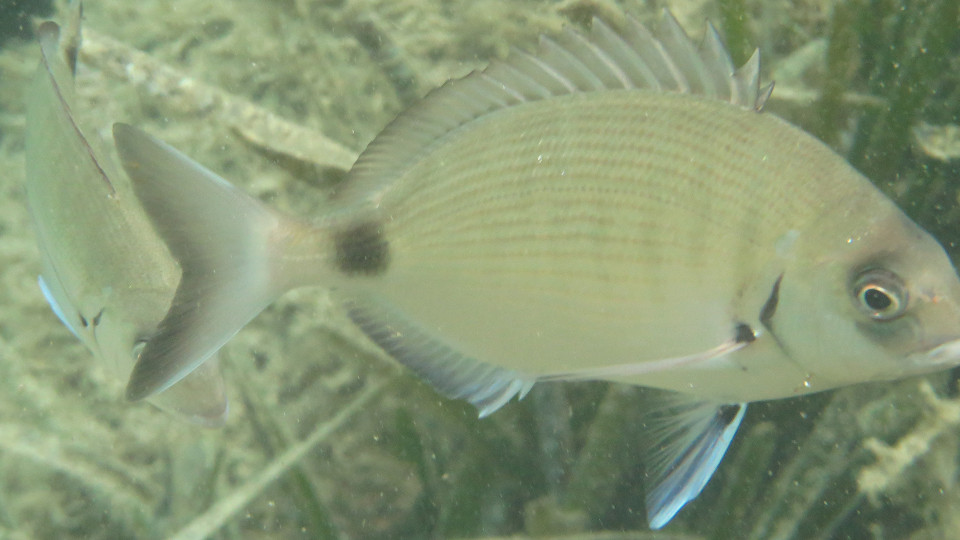
If you have been exploring the mediterranean sea with swimming goggles and snorkel, not far from the shore before or between the rocks, you will surely recognize the animals and plants that you can see here. They are the ones who you can find there all the time, as far as my own experiences go. The photos here on this page originate from the Côte d’Azur and the coasts of Corsica and Sardinia. They have been taken in the rocky infralittoral, that part of the rocky littoral between the lower tide line and the lower limit of the meadows of seagrass. ([Patzner1989], [Weinberg2016])
The specimen in the first image is a Diplodus sargus. Its trivial name is white seabream. Like all fishes described on this page they like to swim close to the ground (as opposed to the open sea). These fishes aren’t just not particularly shy, they are outright curious and like to approach us snorkelers and appear to be interested. They belong to the family of the sparidae (porgies). Clearly visible in the image are the erected spines of the fins, particularly in the dorsal fin. They are however not always as visible as shown here. The ray fins give their name to the large group of the actinopterygii (ray-finned fishes) to which this family also belongs. The large group provides about half of the species in the still larger group of the teleostomi (bony fishes) (Source: [Nelson 2016]). As a practical consequence of this fact you will see here only fishes who belong to the ray-finned fishes. Diplodus sargus can be recognized not only by the clearly visible black spot on the stalk of the tail, but also by the black membrane at the margin of the gill covers. Like all sparidae he has a forked tail fin. The outline of the tail fin is a basic feature which is easily recognizable when snorkeling. This is always a first hint of the group to which these animals belong.
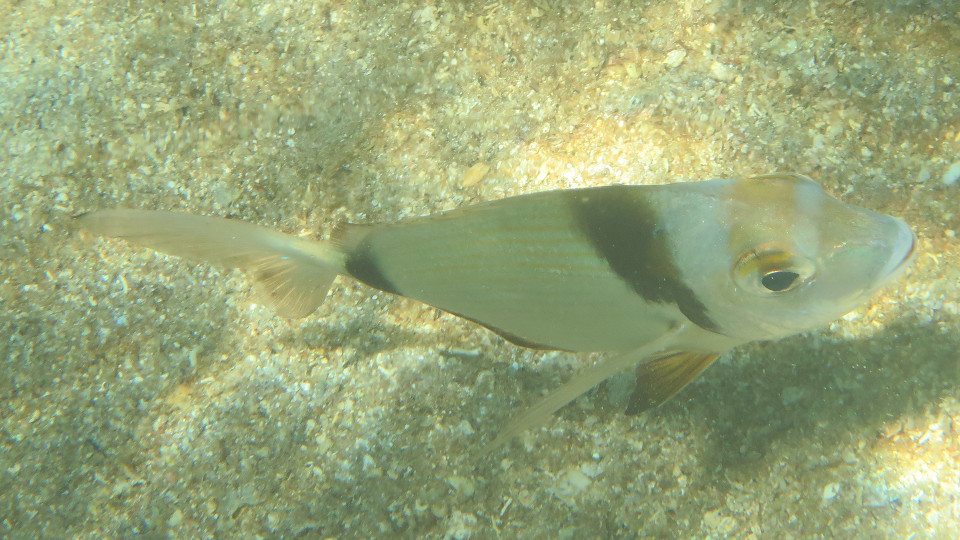
Specimens of another species turned out to be even more curious if not intrusive: I am talking about Diplodus vulgaris, the two-banded seabream shown in the second image. One particular animal literally circled me multiple times while I tried to turn around my own axis to keep it in view. Generally I want to state that fishes do often behave in the wild very differently from what you can see in a zoo or in a big aquarium. Frequently they are much more active, and I started only in that kind of environment to develop a pronounced relationship to them. By the way these animals also have, although not visible on this picture, a dorsal fin with long spines and rays. A black bar on the neck and one at the base of the tail are characteristics. I have also always seen the orange bar above the eyes which is not described as characteristic in the literature, however.
Starting with the next species we turn to a an exciting subject in the biology of fishes. Considering humans and other mammals like cats and dogs we are used to the view that gender is a fixed property of the indivdual. This, however, is not the case for many kinds of fishes, especially in the family of labridae (wrasses). The talk is about Coris julis, the rainbow wrasse. It is a diandric protogynous. That is, it starts its life as a female (♀) and then changes later to male (♂).
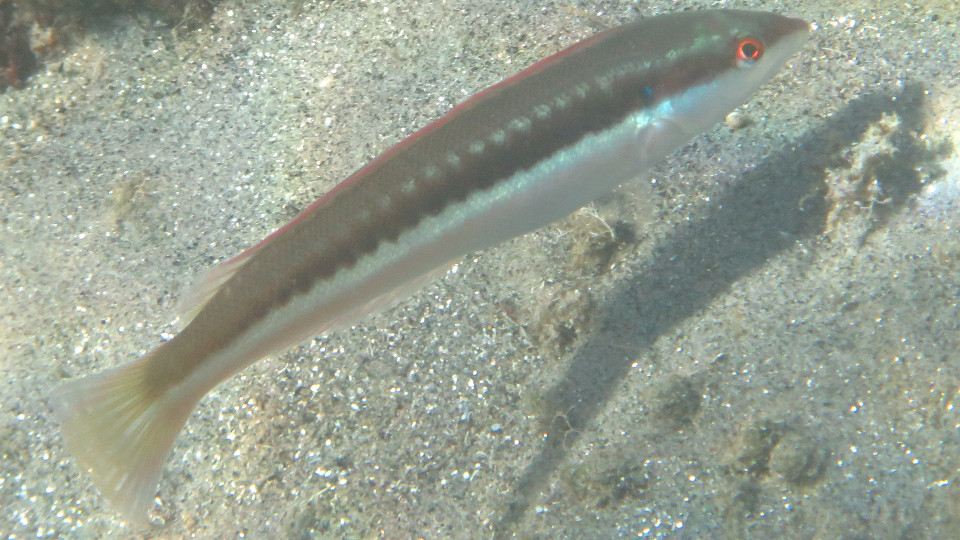
The exact details have not be described scientifically for a long period of time, however. According to current knowledge, the following can be said: The species appears in two different displays, called “initial phase” and “terminal phase”, also as “initial livery” and “terminal livery”. All females and a variable fraction of males display the initial livery. Only the males can display the terminal livery (di-andric: two forms of males).
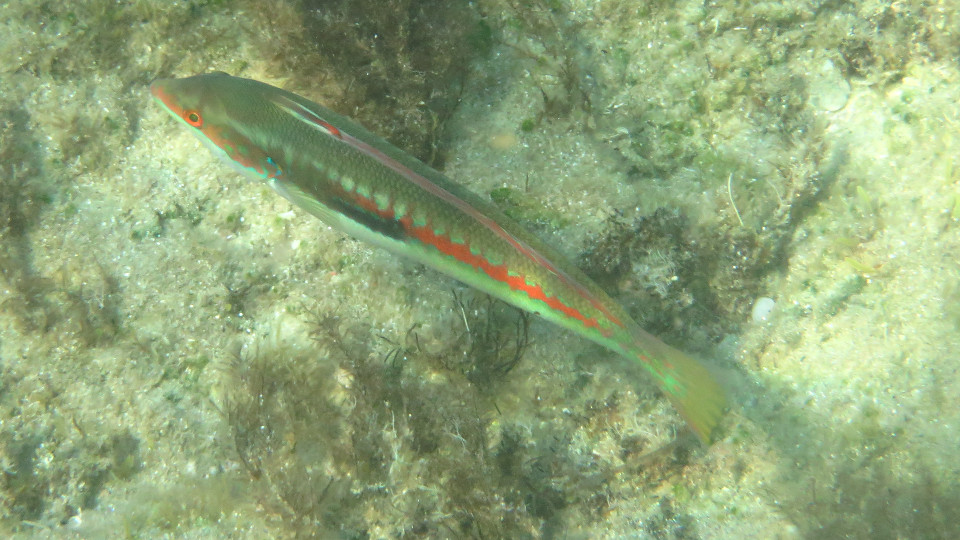
Coris julis in the initial livery can be distinguished by the clearly visible white stripe separating the dark back from the light stomach. The light belly is sometimes coloured yellowish, but the image shown is no good example of that.
The feature which serves best to distinguish the terminal livery is a marked orange zig-zag line between back and stomach. At the flanc there is also an elongated dark spot visible. The back is coloured blue-green.
As you can see, the caudal fin is not forked. This is also not the case for the other representatives of the labridae. The labridae have like the sparidae one dorsal fin.
It is hardly an exaggeration to state that Coris julis is one of most abundant species of the coasts of the mediterranean. Along that the animals in the initial livery occur a bit more often in the vicinity of the beach than those in the terminal livery, according to my own observations.
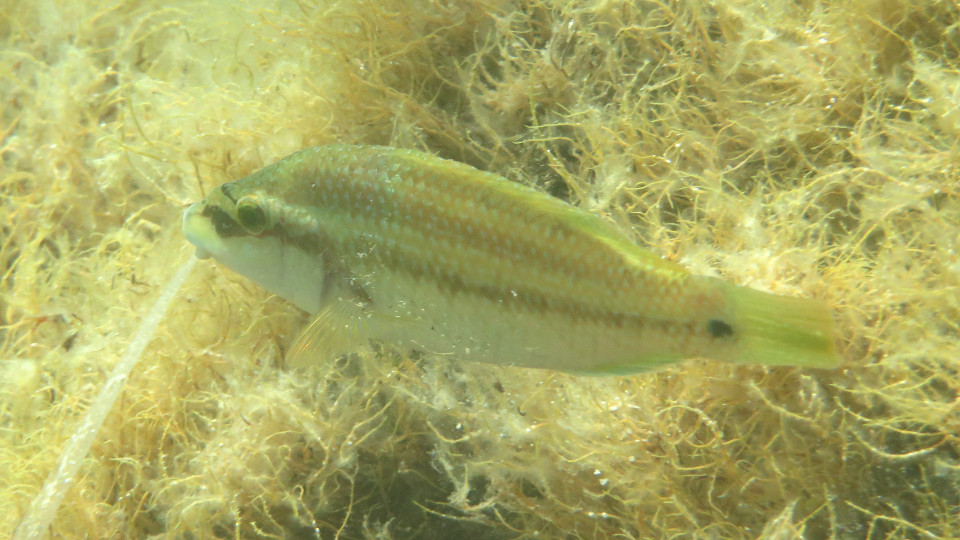
While most of the species which we meet here at the coast inhabit not only all of the mediterranean coasts but also those of the atlantic ocean or beyond, Symphodus tinca, the peacock wrasse, is an endemic species. One can thus encounter it only here in the mediterranean. The once used scientific name Crenilabrus pavo is now outdated. Like most or all labridae the species passes through a phase of sex change from female to male. There are two different liveries, where the terminal livery is the most spectacular one as usual. This presents another case of sexual dimorphism (two forms ♀ ↔ ♂).
The most remarkable feature of Symphodus tinca are the three dark stripes on both sides, one of them right on the back. In most cases you can see also the dark spot close to the caudal fin (which is sometimes missing or faded). The species has also a v-shaped mark above the mouth. The pointed lips are considered characteristical as well. All those statements apply to both liveries. In addition, one has to mention the many blue spots, especially on the fins as visible on the image. By the way, Patrick Louisy describes two other liveries of juvenile fishes in his guide.
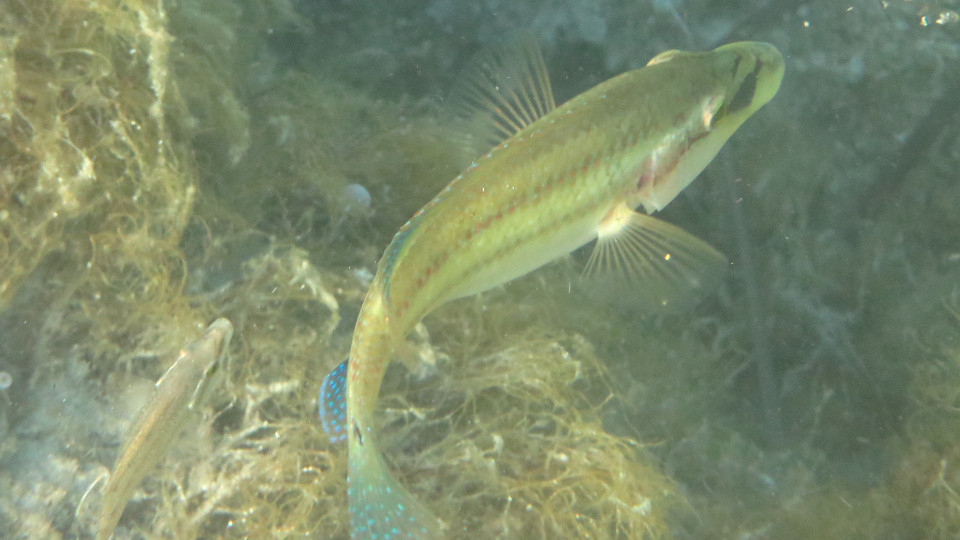
I don’t know whether you are consciuos of the fact that we snorkelers occupy a privileged position among those observing underwater life, because only we experience them in the first few meters below the surface which are flooded with sunlight, and can see them in their natural colours. If you enter a boat and go further out to dive to depths of 20 to 30 or more meters, then you know already that a considerable fraction of the light has been absorbed by the water above, and you are dependent on artificial lighting, and the use of flash. The effect is already present if you dive with the help of your diving fins to depths of 6 to 8 m. Try it out yourself if you feel like doing so! The colours are also affected, because red, orange and yellow portions of the light are the first ones lost, and the green and blue ones are left over. This is the reason why the photos in the usual species identification guides are taken in artificial light, as opposed to my own images, although even I use a camera program for underwater colour correction. The images match nevertheless (or right because of it) my own personal colour impressions. They look just like I have seen the fishes by myself.
The situation is especially impressing with the most colourful species. I want to introduce now two of them to you: At first, Serranus scriba, the lettered perch or painted comber. When I met the species the first time, I hardly recognized it among all the other kinds of fish. This was because it ist quite capable of representing itself as unconspicuous as in the following image:
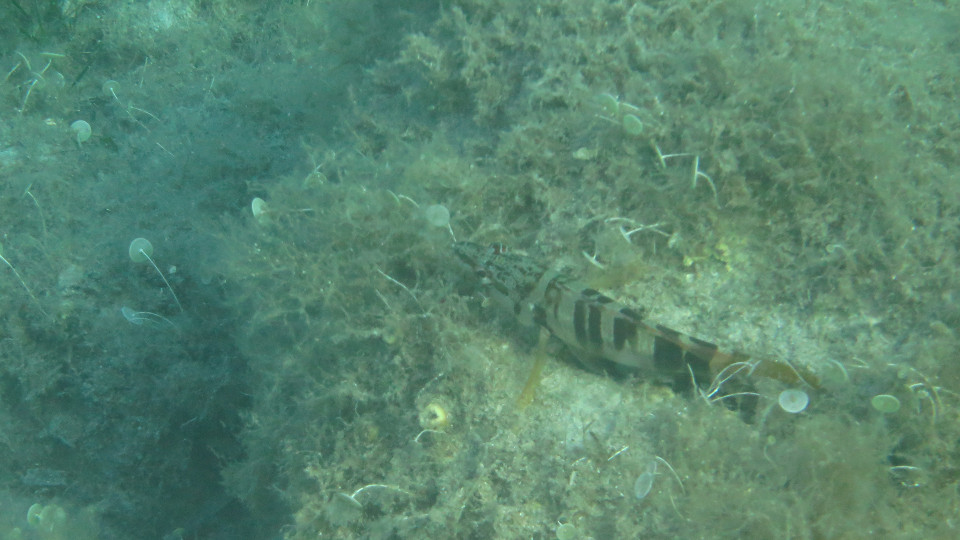
I refer to the fact that it chooses to stay away from us snorkelers and is skillful in hiding below a ledge or between the algae. If you are going to track it down, you want to keep your eyes wide open. And if you have spotted one, you will find that it keeps its distance while you will probably be able to approach it to some degree. Patrick Louisy goes as far as describing it as curious, which does not match my own experiences. Still, “the Riedl” supports that view by writing that it approaches divers close-up to 2 m and then shoots away in his hide. If you loose visual contact, it is still worth the effort to stay where you have been and search it, because the animal is territorial: It remains in its fixed territory.
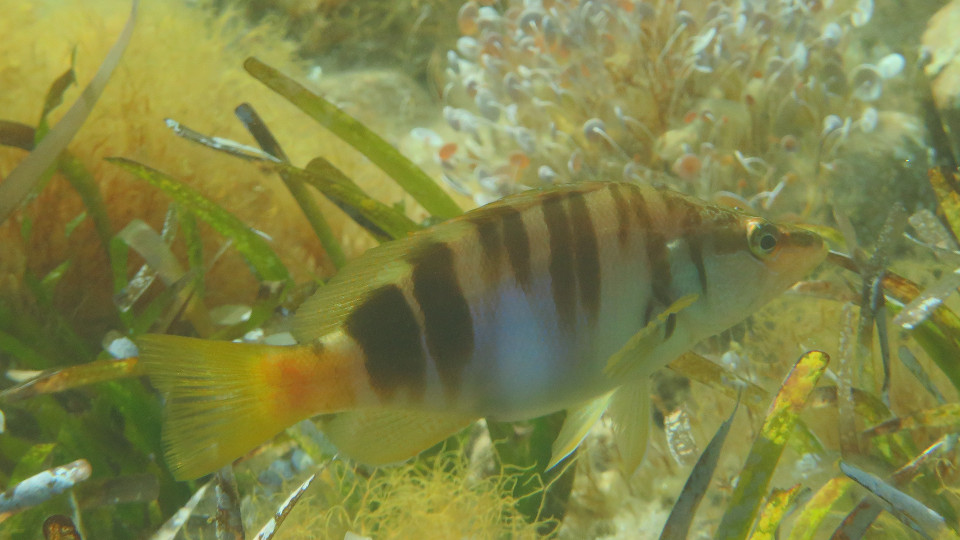
In the case of Serranus scriba, you don’t have to take care of the different looks of females and males, as it is a functional or synchronous hermaphrodite; each individual is female and male at the same time. Thereby we arrive at another instance of the diversity concerning the sexuality of fishes.
Serranus scriba belongs to the family of serranidae (sea basses). The serranidae have one caudal fin which is not forked, just as in the case of the labridae.
Why is a lettered perch called “lettered perch”? You do not find questions like that discussed very often in the literature. But Steven Weinberg writes in his guide on mediterranean sea life: “The redish and blueish paintings on the head resemble to some degree characters in writing, leading to its name” (in my own translation). Look at the next image to check that for yourself.
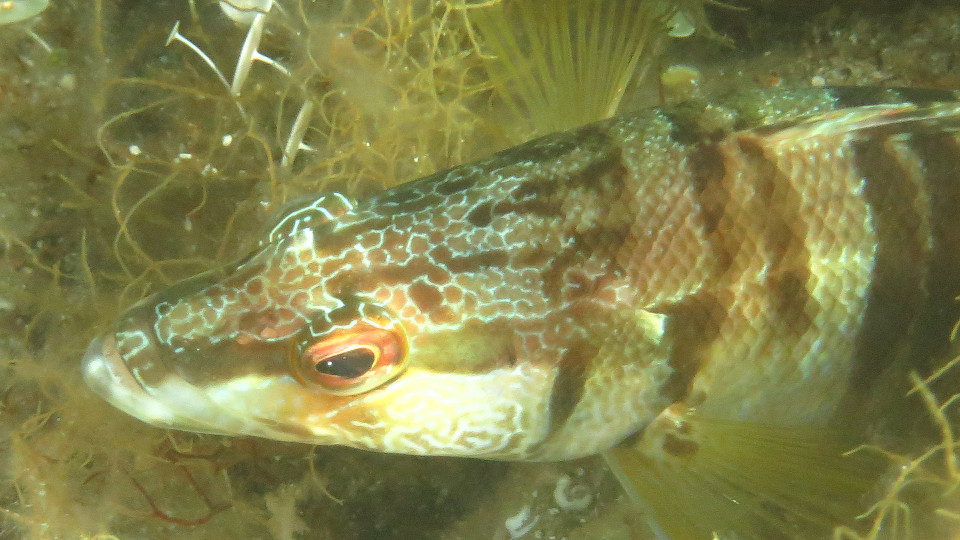
The colours of Serranus scriba, not only of the head but of the whole body, are distinctive and – in my view – very beautiful. However, they don’t look always quite the same, as demonstrated by the next image.
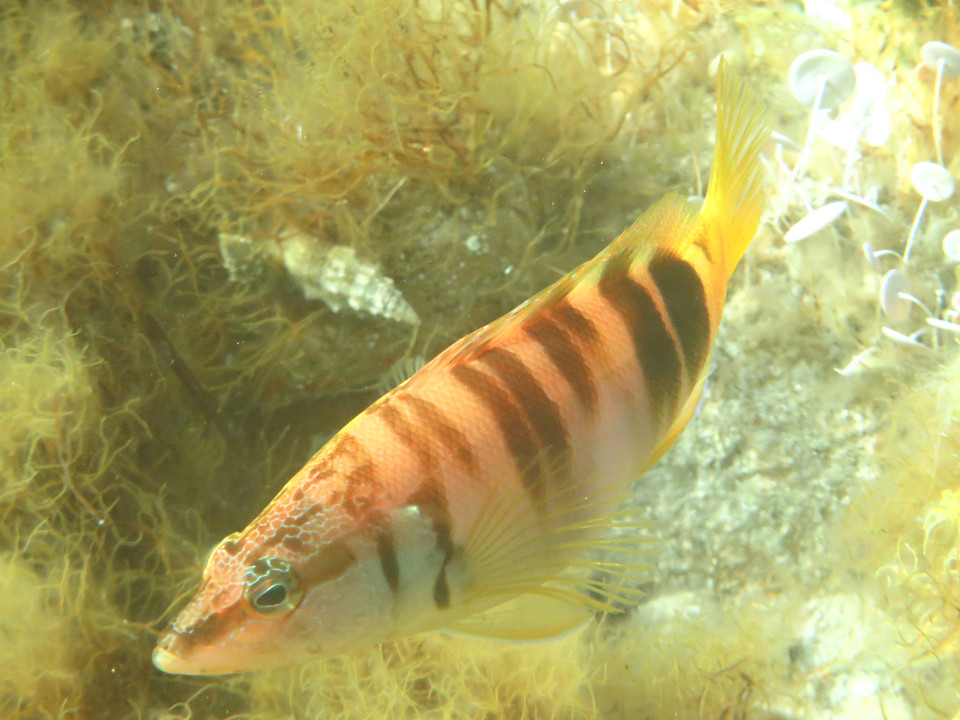
Considering that fact, those features which are always present are especially important. Patrick Louisy names the paired dark stripes, the blue-painted zone of the stomach and the yellow tail. I found all those features present in my own observations.
According to Riedl Serranus scriba is a territorial fish with fixed hiding spots. According to Harmelin it can be found between the rocks as well as close to underwater meadows. Like most of the fishes living in that zone (and most of the other fishes as well, as I will look into it later …) are carnivorous: Riedl describes it as hunting little fish and shrimps.
With some animals it is especially useful to know where to look for them: The next fish in this presentation can be found the brightest zones, very often within the first meter below the surface. And close to the rocks. Both observations taken together frequently means the surf zone where the waves hit the rock, and where special care is advisable.
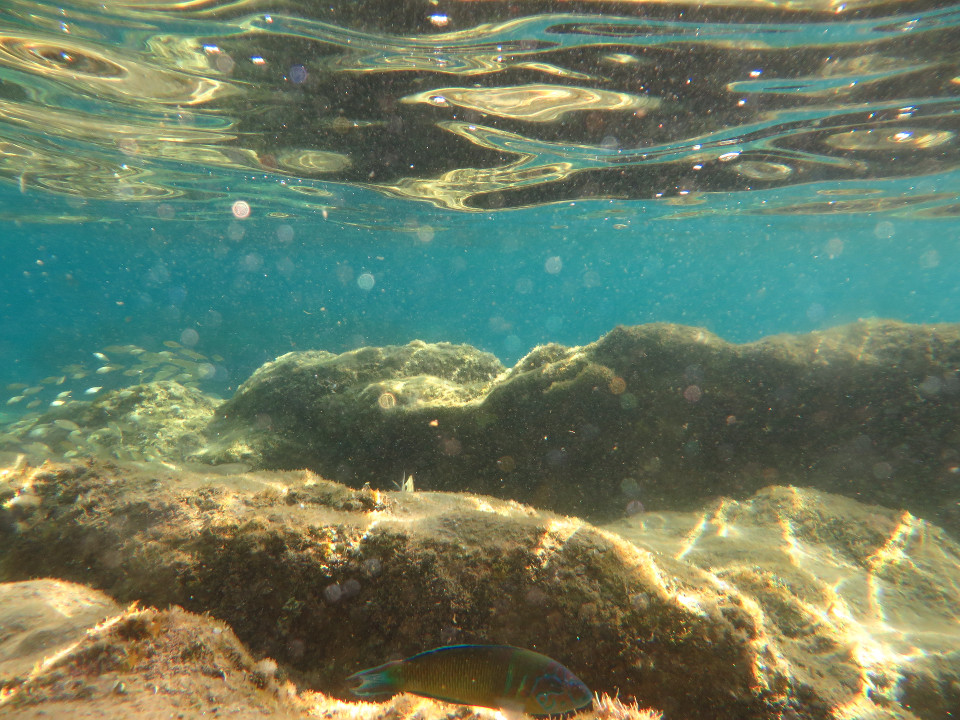
This is where one can find the most beautiful animal that I have seen in the mediterranean. Even its name conjures a vision of its wonderful colours (however more by its latin scientific or by the german trivial name both refering to the peacock): Thalassoma pavo, the ornate wrasse or turkish wrasse.
It is another member of the family labridae, and therefore not surprisingly a protogynous. The individuals in the initial livery are females (♀). When they begin to change their sex to male (♂), it also becomes visible in their appearance. You can find more details of those changes in the guide of Patrick Louisy [Louisy 2015] to which I refer another time with pleasure, and with the same pleasure to the guide of Steven Weinberg [Weinberg 2015].
The basic colour of the females is yellow-green, depending on the individual sometimes more like orange. They possess five turquoise or cyan vertical bars, and there is also a black spot right on the back. The caudal fin ends in a straight line with the young individuals, but is fringy with the females, “like a lyre”, meaning that the rays on the margin are longer than those in the middle. Both sexes have thin vertical lateral lines and an intricately linked blue pattern on their heads (Louisy). According to my own observations the blue colour of that pattern is darker for the males. ♀ and ♂ can both grow to a length of 20 to 25 cm. The individuals that I myself have observed were probably somewhat shorter. According to Weinberg this species is one of the most colourful of the mediterranean, and is similar to tropical fishes. He continues to write that they are witnesses of the geolocial era of the (tropical or subtropical) Tethys sea which extended to our current geographical latitutes. And that even today fishes of genus Thalassoma are well represented in the tropical oceans.
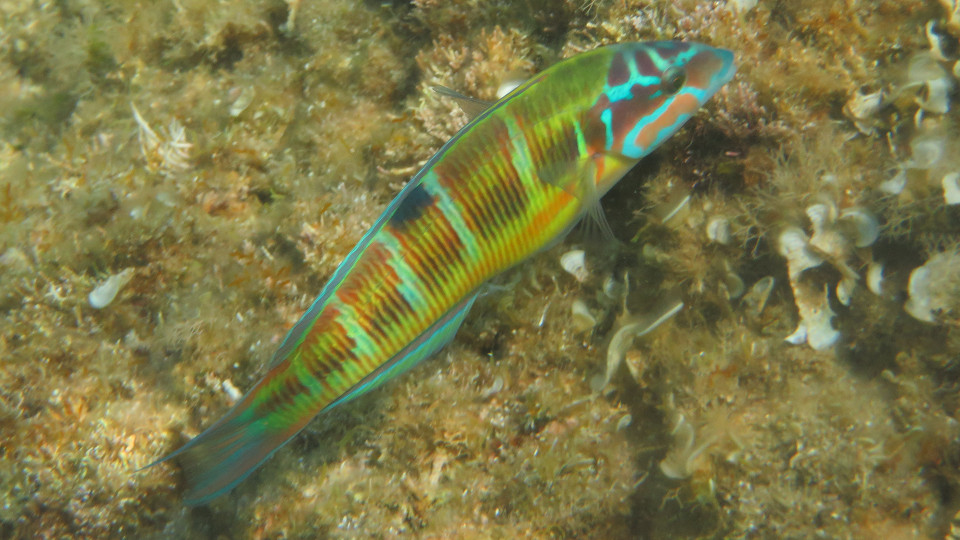
The animals in the terminal livery, the males (♂), are as gorgeous as are the females (♀), but present obvious differences in appearance. As opposed to the females, they have only one turquoise bar behind the head. The body is more massive, and the tips of the tail more pronounced. The black spot on the back has vanished.
According to DORIS, the ornate wrasse is “carnivorous, a predator, feeding mostly on small invertebrate animals which it finds in the substrate, in the sand or in the Neptune-grass like crustaceans, mollusks, worms …” (in my own translation). I have found them to be extremely agile fishes, often moving fast, and therefore harder to observe and to take photos of. If one is not determined enough to pursue them, one can easily loose visual contact. On the other hand, I have also found them at places where they stayed for a longer while. They appear to be territorial, as I have – sometimes only after a longer search – found them in the same regions, limited to a size of perhaps 20 m times 20 m, and at some special places between the rocks.
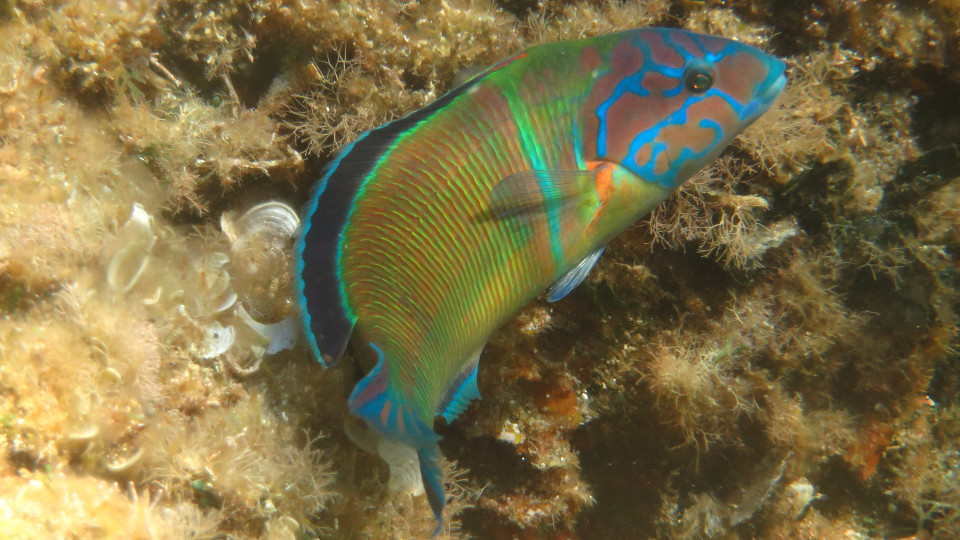
During years I’ve met Thalassoma pavo only as single animals, sometimes two females, sometimes two females and a male, rarely more than that. Somewhere I had seen a video clip showing many specimens at the same time. But I had to wait until my first visit to the east coast of Sardinia to make this experience myself. There the species is called donzella pavonina [Ambiente2021]. Sometimes I could see schools of perhaps 30 specimens and more, swimming over sandy ground not far from underwater rocks. The behaviour of the fishes in such groups was fascinating. Those groups contained a lot of females, maybe some with different liveries, some males, sometimes even transitional forms between female and male. However, I found it hard to make sense of the fast movements, which were shown mostly by the males. One would perhaps suspect some sort of courtship or showing off behaviour, but that was not obvious. I did also not notice any territory fights. At least the time of reproduction, in the summer months ([Bergbauer2017]), would match.
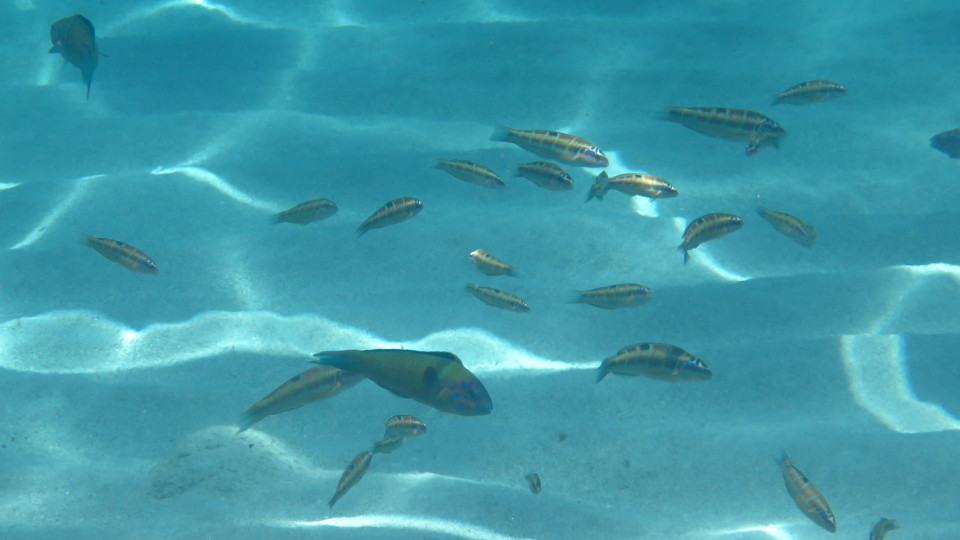
All images in this article are taken and processed by myself.
